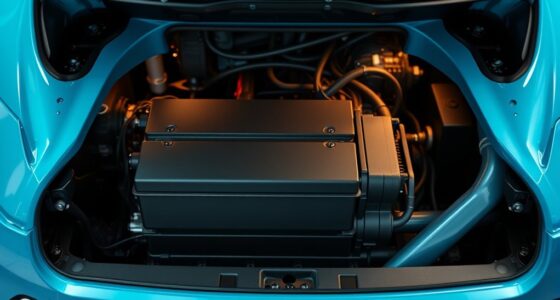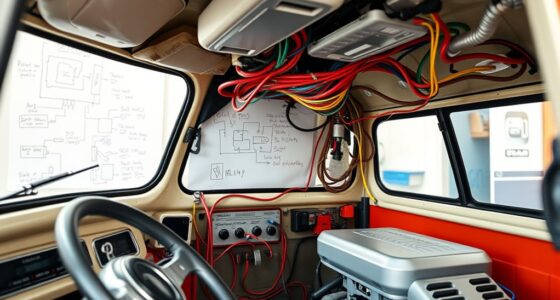Solid-state batteries could substantially improve electric buses by offering safer, more durable, and higher-energy options. They use solid electrolytes, reducing risks like leaks and fires, which boosts safety in urban operations. Although manufacturing costs are currently high, ongoing research aims to lower expenses and enhance performance. As these batteries develop, they promise longer ranges and reduced maintenance. To understand how these advancements could shape transportation, discover more about their emerging prospects and challenges.
Key Takeaways
- Solid-state batteries significantly enhance safety by reducing fire and leak risks in electric buses.
- Higher energy density enables longer bus ranges and improved operational efficiency.
- Manufacturing complexities and costs currently limit large-scale adoption despite safety benefits.
- Ongoing research aims to reduce production costs and improve durability for commercial deployment.
- Future prospects depend on technological advancements and cost reductions to enable widespread use.

As electric buses become increasingly essential for sustainable transportation, solid-state batteries are emerging as a promising technology to overcome current limitations. One of the key advantages of these batteries is their potential to improve battery safety. Unlike traditional lithium-ion batteries that use liquid electrolytes, solid-state batteries utilize a solid electrolyte, which considerably reduces the risk of leaks, fires, and thermal runaway. This safety enhancement is vital for electric buses, which operate in urban environments where passenger safety and reliability are paramount. With fewer safety concerns, transit authorities can deploy electric buses with greater confidence, reducing the need for extensive safety measures and maintenance.
Solid-state batteries enhance electric bus safety with solid electrolytes, reducing leaks, fires, and thermal risks in urban transit.
However, while solid-state batteries offer safety benefits, their manufacturing costs present a notable challenge. Producing these batteries is more complex and costly than conventional lithium-ion types, primarily due to the advanced materials and precise fabrication techniques involved. The solid electrolytes, often made from ceramics or sulfides, require high-temperature processing and meticulous manufacturing conditions, which drive up production expenses. These higher costs currently make scaling up production difficult, potentially limiting widespread adoption in the short term. Yet, as research progresses and manufacturing processes mature, these costs are expected to decrease, making solid-state batteries more economically viable for large-scale use in electric buses.
You’ll also find that solid-state batteries promise higher energy density, meaning these batteries can store more power in a smaller, lighter package. This translates directly into longer ranges for electric buses, reducing the frequency of charging stops and increasing operational efficiency. As a result, transit agencies might see lower total ownership costs over time, despite the higher initial investment. Additionally, their durability and resistance to degradation mean your electric bus can maintain performance over more charge cycles, further enhancing long-term savings and reliability.
Despite these promising features, the transition to solid-state batteries isn’t without hurdles. The technology is still in the developmental and early commercialization stages, with ongoing research focused on improving manufacturing techniques and reducing costs. As you consider future electric bus deployments, it’s essential to weigh these factors—safety improvements against current cost barriers—to determine when large-scale adoption will become practical. With continued innovation, solid-state batteries could revolutionize electric bus technology by offering safer, longer-lasting, and more efficient power sources. For now, their potential remains promising, and staying informed about advancements will help you make strategic decisions for sustainable transportation solutions.
Frequently Asked Questions
How Do Solid-State Batteries Impact Bus Design and Weight?
Solid-state batteries impact bus design and weight by enabling more compact battery packaging and better structural integration, which reduces overall weight. With their higher energy density, you can design lighter, more efficient buses that maximize space and performance. This allows for improved passenger capacity and range, while the streamlined battery packaging enhances safety and durability. As a result, solid-state batteries help you create buses that are both lighter and more robust.
What Are the Safety Advantages of Solid-State Batteries Over Lithium-Ion?
Think of solid-state batteries as the safety vaults of energy storage. They’re less prone to overheating or catching fire, unlike lithium-ion batteries. This means better battery longevity and fewer recycling challenges down the line. You get a more reliable, safer power source that reduces risks and environmental impact. By choosing solid-state, you’re investing in a future where safety and sustainability go hand in hand, making your electric bus journeys safer and greener.
How Soon Will Solid-State Buses Become Commercially Available?
Solid-state buses are expected to become commercially available within the next 5 to 10 years. This timeline depends on advancements in battery manufacturing and infrastructure development. You’ll see progress as companies refine solid-state technology, scale production, and build charging networks. While some prototypes are emerging, widespread adoption hinges on overcoming technical challenges and ensuring cost-effectiveness. Stay tuned, because this shift could revolutionize electric bus transportation soon.
What Are the Cost Implications of Adopting Solid-State Batteries?
You’ll face higher initial costs with solid-state batteries due to advanced battery manufacturing and a developing supply chain. These batteries demand new materials and processes, which can increase production expenses. However, over time, you may save on maintenance and replacement costs thanks to their longer lifespan and improved safety. Balancing these upfront investments against long-term savings is key to understanding the true cost implications of adopting solid-state batteries.
How Do Solid-State Batteries Perform in Extreme Weather Conditions?
Solid-state batteries generally perform well in extreme weather conditions thanks to their superior thermal management and temperature resilience. You’ll notice that they maintain stable performance in both cold and hot environments because they handle temperature fluctuations better than traditional batteries. This durability reduces the risk of capacity loss or safety issues, making them a reliable choice for electric buses operating in diverse climates.
Conclusion
As you consider the future of electric buses, solid-state batteries shine like a beacon of innovation, promising to revolutionize transportation as you know it. With their potential for longer range, faster charging, and enhanced safety, these batteries could propel us into a new era—faster than you can imagine. Embracing this technology isn’t just smart; it’s your ticket to transforming city transit into a smooth, silent, unstoppable force that will redefine how we move.









